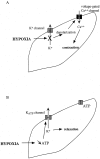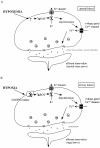Physiological and pathological responses to hypoxia
- PMID: 15161623
- PMCID: PMC1615763
- DOI: 10.1016/S0002-9440(10)63747-9
Physiological and pathological responses to hypoxia
Abstract
As the average age in many countries steadily rises, heart infarction, stroke, and cancer become the most common causes of death in the 21st century. The causes of these disorders are many and varied and include genetic predisposition and environmental influences, but they all share a common feature in that limitation of oxygen availability participates in the development of these pathological conditions. However, cells and organisms are able to trigger an adaptive response to hypoxic conditions that is aimed to help them to cope with these threatening conditions. This review provides a description of several systems able to sense oxygen concentration and of the responses they initiate both in the acute and also in long-term hypoxia adaptation. The role of hypoxia in three pathological conditions, myocardial and cerebral ischemia as well as tumorigenesis, is briefly discussed.
Figures




References
-
- Yuan XJ, Tod ML, Rubin LJ, Blaustein MP. Contrasting effects of hypoxia on tension in rat pulmonary and mesenteric arteries. Am J Physiol. 1990;259:H281–H289. - PubMed
-
- Post JM, Hume JR, Archer SL, Weir EK. Direct role for potassium channel inhibition in hypoxic pulmonary vasoconstriction. Am J Physiol. 1992;262:C882–C890. - PubMed
-
- Archer SL, Weir EK, Reeve HL, Michelakis E. Molecular identification of O2 sensors and O2-sensitive potassium channels in the pulmonary circulation. Adv Exp Med Biol. 2000;475:219–240. - PubMed
-
- Lopez-Barneo J, Pardal R, Ortega-Saenz P. Cellular mechanism of oxygen sensing. Annu Rev Physiol. 2001;63:259–287. - PubMed
Publication types
MeSH terms
Substances
LinkOut - more resources
Full Text Sources
Other Literature Sources
Research Materials

